URLINGAME B THE
AI-generated art threatens human creators
 BY ISABEL LIU Copy Editor
BY ISABEL LIU Copy Editor
Four months ago, a Reddit user published a post titled: “Battle of the Sams! Which SamDoesArts Model does it best?” e post featured eight illustrations of a woman standing against a desert night. e pieces mimicked popular digital artist SamDoesArts’ compelling painting style and use of color.
However, this Reddit user didn’t do any painting. ey generated eight di erent renders using arti cial intelligence (AI) models and uploaded them to r/StableDi usion, a subreddit dedicated to popular text-to-image generative AI models.
e post generated controversy. SamDoesArt made a public statement against the AI art models for feeding 300 of his artworks into AI without his consent, but the Reddit user responded con dently that artists shouldn’t be o ended because Stable Di usion could “recreate [Sam’s] work, perhaps even improve it.”
SamDoesArts’ story is one of many resulting from AI art’s recent explosion of popularity. In 2022, AI art generators such as DALL-E 2 and Midjourney were released, enabling anyone to generate an image according to a text prompt they entered. To do this, the AI is trained on millions of images and their captions to learn how much a given string of words relates to an image.
“ eoretically, I’m opposed to [AI art], but in practice, it’s so cool and helpful,” junior and advanced art student Julia Edmondson said.
Similarly, art teacher and former so ware engineer Eislyn Wolf-Noyes believes AI opens many doors for creativity, especially as someone with unique experience in both the tech and art world.
“I love to see what people who don’t consider themselves artists can make through the AI interface. It would be like having an artist friend… ey can put in criteria and use the AI to massage the artwork into place,” Wolf-Noyes said.
Despite AI’s remarkable capabilities, some Burlingame artists believe the art it creates is missing the emotion that is inherent in human-made work.
“Art is a way to express myself. I don’t know if there’s any really deep meaning behind it. at can only be created by humans,” sophomore and Advanced Placement Art student Luke Frikert said. “I don’t think AI art really compares because it lacks emotion.”
Iron Panthers' hard work pays off at MBR

 BY BRINDA IYER Sta Reporter
BY BRINDA IYER Sta Reporter
On Wednesday, March 29, e Iron Panthers participated in the Monterey Bay Regional (MBR) robotics competition, reaching the semi nals.
is is probably the best our robot has ever performed,” senior and co-captain Kristen Tran said. “We’ve improved a lot since the beginning of the season.”
e objective of the challenge mirrored that of the Central Valley Regional (CVR) competition, which the team attended in March.
e robots had to drive up to a cube, pick it up and take it back to their starting positions. e goal was to fetch as many cubes as possible. e robots then did an activity to see which one could balance on a ramp for the longest. e team learned from its mistakes at CVR, ending the season with a far better performance.
“With other [competitions], everyone [was confused], and it was more complicated,” sophomore Cindy Chen said. “But with [MBR], everyone knew what to do, and we weren’t that stressed out.”
A er three consecutive losses against rst place and previous world champion Madtown Robotics, the Panthers began at the bottom of the rankings. But, over the next two days, the team’s perseverance pushed them to the top.


“Belief in our abilities and having a positive attitude [really helped us],” team coach Christina Wade
said.
Before MBR, the Panthers made the last-minute decision to take part in the Sacramento Regional Competition, which helped them x technical issues with the robot and work on communication — two challenges they encountered at CVR.
“[Sacramento] helped us work out some of the kinks, so we were con dent [entering] Monterey,” Wade said.

Going into MBR, the Panthers focused on qualifying for the world competition. Despite losing to Spartan Robotics of Mountain View High School and failing to qualify, the team agreed that they presented their best possible work.
“We were not able to beat some of those powerhouse teams that are a level above us,” sophomore and engineering lead Zack Weinberg said. “But, besides that, I think we got what we wanted. We did really well, [our robot was] reliable, and we’re pretty proud of that.”
Many underclassmen took on bigger responsibilities, especially on the engineering side. Unlike previous years, freshmen constructed the majority of the robot.
“[MBR] is one of the rst competitions where I did not have a reason to touch the robot,” junior and student lead Connor Lu said. “I was con dent that the robot was going to be taken care of. Being stressfree as a lead on this team is a really great feeling.”
e Panthers are con dent that they will excel in next year’s compe-
titions, despite losing seniors.
“[We] learned a lot about how to use tools and about di erent concepts,” freshman Adrian Su said of his rst season. “I think we’re going to be able to pick up the slack that the seniors are leaving.”
e team will also receive anancial boost from sophomore Julien Mott, who won a $5,000 STEM grant as a runner-up in a collegiate robotics competition hosted by Connecticut-based robot combat league National Havoc (NHRL).
Mott discovered his passion for robotics in 2018. Two years later, with the help of senior Jasmine Cheng, Mott began working on his NHRL robot. As the youngest team, Mott entered the competition with low expectations.
“I was pleasantly surprised to see that putting time and e ort into the project really [was] rewarded with success,” Mott said. “It was very nice to see that despite all that I’ve learned in this time, dedication, ambition and hard work [is] what makes the di erence.”
Mott’s in uence went beyond Burlingame. While scrolling through Instagram a er the competition, he saw that a robotics team in Mexico made a cake with his robot as the centerpiece. Knowing that he impacted people on a global level was “heartwarming,” Mott said.
“I hope that I can use my inspiration to inspire others,” Mott said. “I really love robotics, and I want other people to enjoy it as much as me.”

April 18, 2023 Burlingame High School, 1 Mangini Way, Burlingame, CA 94010 Issue 6 Vol 138
INSIDE Dyslexia screening closes inequity 2 6/7 9 12 Italian students travel abroad Track stars shine in diverse events Games, crossword and more
WHAT’S
PHOTO COURTESY OF IRON PANTHERS
GRAPHIC BY ISABEL LIU
Isabel Liu’s watercolor of red baby birds compared to an AI-generated piece by NightCafe.
See AI ART, page 2
e Iron Panthers traveled to Monterey for their nal competition of the season, reaching the semi nals.
B THE BURLINGAME B
Editor-in-Chief Jackson Spenner
Managing Editor Elise Spenner
Design Editor Sophia Bella
Sports Editor Michelle Moshkovoy
Head Photographer Jake Rothstein
Business Manager Alex Kelly
Social Media Manager Amanda Nolan
Web Editor Arda Inegol
Diversity Coordinator Lizzy Wan
Social Coordinator Kristie Kim
Copy Editors
Arshia Chakravartti
Isabel Liu
Senior Reporter
Daria Burnosova
Staff Reporters

Theo Au-Yeung
Athena Bostonmaer
Jeannine Chiang
Danny Conway
Sophia Doss
Natalie Gyde
Joelle Huysmans
Brinda Iyer
Abby Knight
Will Kriner
Ana Lunaparra
Ellie Neuman
Zachary Newman
Sophia Puzon
Ruby Rosenquist
Zach Shapiro
Teacher Adviser
Melissa Murphy
Policy Statement:
The Burlingame B is a student-run newspaper with the role purpose of providing an open forum for student expression. Anything printed represents the opinion of the writer, but not necessarily that of the Burlingame B staff, the administration, or the faculty of Burlingame High School, or anyone affliated with the San Mateo Union High School District. The Burlingame B does not discriminate against race, political oritentation, ethnicity, religion, gender, sexual orientation or disability. Although The Burlingame B will never refuse to publish guest submission based on the aforementioned factors, we reserve the right to edit or not publish them.
Letters to the Editor
Disagree with the writers? Bring your letters to the room A120 or email them to <theburlingameb@gmail.com>. Letters may be considered for publication. The Burlingame B reserves the right to edit for clarity, length, and accuracy. We welcome all comments.
Website: www.theburlingameb.org
Phone: (650) 558-2899
Email: theburlingameb@gmail.com
Address: 1 Mangini Way, Burlingame, CA 94010
State debates dyslexia screening
BY ISABEL LIU
Copy Editor
On ursday, Feb. 16, Senator Anthony J. Portantino introduced Senate Bill 691 to the California State Senate, which would require students from kindergarten to second grade to be annually screened for risk of dyslexia, a learning di culty that a ects reading and spelling.
For the past eight years, the State Senate has unsuccessfully attempted to pass similar legislation. At the moment, California is one of 10 states that don’t have universal mandated dyslexia screening. e California Teachers Union (CTA) repeatedly blocked this legislation, claiming screening takes too much time and over-identi es English learners.
Even so, reading is involved in all learning, putting dyslexic students at a long-lasting achievement gap which could be solved with early intervention, the Journal of Pediatrics found.
e Journal of Educational Psychology reported that students at risk for reading disabilities who received intervention before third grade made gains twice that of children who received intervention during third grade.
“[If] the state has the resources, I think all students should be screened,” senior Sam Storey said. Storey recently published a research paper on low-cost things elementary schools can do to support dyslexic learners, inspired by her younger brother’s experience. “In mainstream schools, I don’t feel like there’s many resources on dyslexia.”
Unlike many school districts in California, Burlingame School District (BSD) has im-
plemented universal dyslexia screening and literacy tests in elementary schools. BSD’s early literacy program is relatively extensive: besides the assessments, it includes a dyslexia committee, an updated English curriculum and training on the science of reading for kindergarten through third graders for teachers.
Still, BSD’s program highlights the CTA’s concerns with dyslexia screening, speci cally about how much time it requires. For example, teachers need training to di erentiate reading di culties and language learning. BSD also does literacy assessments three times a year.
“We do a lot of assessments. People argue it’s bad, but… it doesn’t take that long for us to do and then we can really target where we need to be,” BSD Response to Intervention specialist Tara Cook said. Response to Intervention (RTI) specialists lead BSD’s literacy program and are trained to provide early identication and support of students with learning or behavior needs.
RTI specialists cannot diagnose dyslexia, but they work in multi-tiered intervention responses designed to get students to the right place if they need more support. For example, the specialist may start working with whole classes, then slowly narrow down the group and increase support until there is a sign that further action is needed.
“We meet with the teachers… and decide what we’re gonna be doing in class with [struggling students],” Cook said. “If kids aren’t making progress, then we look into whether they might have a learning disability.”
However, the lack of a diag-
nosis means students can’t receive accommodations or support, like 504 plans. Some are calling for schools to employ more individualized support or personnel that can diagnose dyslexia. But dyslexia is a spectrum that impacts 20% of the population, making it di cult to nd a one-size- ts-all solution.
“[ e school said,] ‘We’re just gonna say it’s challenges but I’m not authorized to say dyslexia,’… ey don’t teach you how to deal with it,” English teacher C. Marina Junqueira said, describing her dyslexic daughter’s experience. “It’d be great if there could be a side class where they say, ‘Here’s some tips and tricks.’ But I think in the mainstream classroom with 35 students, it’s almost impossible.”
Additionally, getting a diagnosis and school accommodations costs time or money, something not every family has. “ ere needs to be a more accessible way to get a dyslexia diagnosis,” Storey said. “My brother and I are fortunate enough that our parents were able to get us tested; it’s expensive to get tested.”
Storey also pointed out that stigma and ignorance makes receiving help di cult.
“I’ve been in class [with students] who are dyslexic, and I see them get cold called to read and put in uncomfortable positions. I feel like there’s a lack of understanding of dyslexia among teachers, parents, fellow students,” Storey said. “Dyslexia is a superpower…I wish I could just tell all these kids, ‘It’s gonna be a challenge, but there’s so much good that could come from it.’”
AI art poses challenge for creative careers
FROM PG. 1
Wolf-Noyes agreed.
“If you’re feeding other people’s artwork into a computer and having it spit something out, that becomes less about your experience as a human,” Wolf-Noyes said. “You could make the case that humans should not be able to make pro t o of the work when they’re not the actual artists themselves.”
And there’s where the greatest controversy lies — AI art and tech companies could eat away at artists’ jobs.
Edmondson believes that AI
art poses a threat to aspiring artists’ career options. She raised the example of her uncle, who makes his livelihood as a font designer.
“[My uncle] has a very solid lifestyle, and it made me feel like that would be something that I could do… But with AI, it could take over his job and now I’m like, ‘Probably shouldn’t do that,’” Edmondson said.
In February, Net ix used AI to generate backgrounds for the animation e Dog & e Boy.
ough Net ix claimed it was
due to the labor shortage in the anime industry, Twitter users contended that it was an issue of livable working conditions: in 2019, top anime talent had annual earnings of just $36,000.
“AI does pose issues for artists who already have trouble making money right with their art. But that’s more of a society bias… ere’s always been an issue,” Wolf-Noyes said. “Ideally society would say, ‘We have to do something to support this group of people who’s disenfranchised.’”
NEWS APRIL 18, 2023 2
GRAPHIC BY BRINDA IYER
BART delays and cancellations impact students’ transport
at’s why my friends and I take Caltrain instead.”
Furthermore, California’s unusual winter storms damaged many train cars. According to the San Francisco Chronicle, only 50% of BART trains were on time in January due to the abnormal weather. e waiting period a er delayed trains caused some safety concerns for Alberts.
“ e worst BART [train] station is Balboa Park. at one looks like a jail and there are de nitely people who have some sort of mental illness who have nowhere to go. It’s really nerveracking, especially in the Daly City BART [station]. We just watch dudes get into the BART elevator [and watch them] hotbox for 40 minutes. When some old lady opened the door, four guys came out and they looked really sketchy,” Alberts added.
like 60 minutes of waiting time between trains, closed stations, and discontinuation of weekend service.
“If weekend services were canceled, all the people that are mainly relying on the train to go out would have a hard time because BART [trains] are the cheapest and fastest option. As a student, I take BART mostly on weekends, which would a ect my e ciency to work my job,” junior Chloe Chan said.
BY JEANNINE CHIANG Sta Reporter
With over 10,000 scheduled Bay Area Rapid Transit (BART) trains canceled in 2022 — triple the cancellations recorded in 2021 — some students have struggled to nd a reliable source of transportation. Although most students only take BART for weekend outings, some take it more regularly, including freshman Leo Saltanov. Saltanov relies on public transportation to see his grandparents in the East Bay, so the BART train delays and cancellations were especially troubling for him.
“When there are train cancellations, I usually wait for the next train. Although the next
train usually arrives within 20 minutes [a er the rst train would leave], the second train could get delayed, too. ere was once where I had to wait over an hour for BART, and it was really frustrating,” Saltanov said.
e delays and cancellations of BART trains stem from three main sources: extreme weather conditions, sta shortages and malfunctioning train car equipment. According to the San Francisco Chronicle, cancellations surged during March of last year when the red line encountered a broken power cable. Because of the winter storms, many car trains were damaged and unable to recover from the impairments a er. e broken
CAMPUS EVENTS
BY ISABEL LIU, KRISTIE KIM, ABBY KNIGHT AND NATALIE GYDE
School elections
A er a week of campaigning, juniors, sophomores and freshmen voted for the 2023-2024 year class cabinets and Associated Student Body (ASB) leadership on Monday, April 10.
Ice cream social
On Friday, April 7, Diana Schumaker, director of national sales for Parker Food Group, joined Shannon Couch’s 4th period Culinary Class to teach students the business aspects of the food industry.
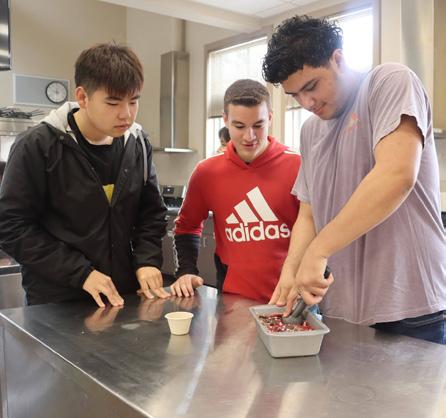
Band competition
On Friday, Apr. 7, wind ensemble members le during ex time to compete in the 2023 California Music Education Association (CMEA) Band and Orchestra Festival.
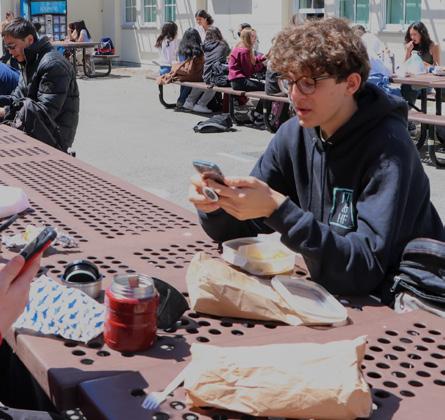
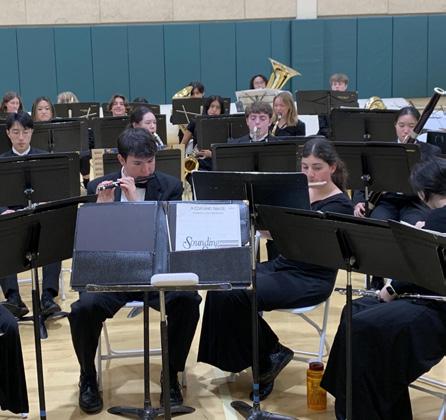
March Madness
On Friday, Mar. 23, leadership hosted the nals of its March Madness tournament, where Ms. Bellas’ junior class beat Mr. Feldis’ senior class by a score of 23-18.
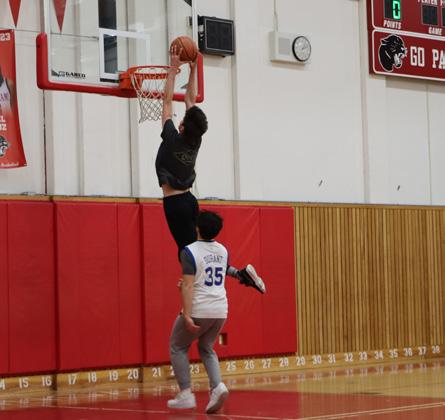
power cable caused a temporary closure of the route and as a result, one in 10 scheduled trains was canceled. BART’s green line, which runs from North San Jose to Daly City, and red line, which runs from Richmond to Millbrae, were responsible for most of the recent cancellations.
“
ere’s been a lot of delays,” junior Tanat Alberts said. “One time we [Alberts and his friends] were taking it [BART] back from the city. e train just stopped for a really long time. e conductor [didn’t say] anything, [nor did they] make an announcement of why they stopped. ey just stopped for a really long time and unfortunately, this is pretty frequent.
On the ip side, police actions, implemented for the safety of riders, caused 26% of delays from April to June in 2022. Nevertheless, numerous riders fear for their safety when riding BART trains. As stated by the San Francisco Chronicle, 67% of riders approve of BART trains but remain concerned about quality-of-life issues such as cleanliness, personal safety, and homelessness in trains and stations.
Delays are unlikely to be temporary. Since ridership in recent months has decreased by about 40% from pre-COVID levels, the BART has been depending on federal emergency funds. ese are predicted to run out in 2025, resulting in changes

LETTER TO THE EDITOR
Dear Editor,
On behalf of the Burlingame High School administration, I want to provide additional balance, perspective, and factual information to the article titled Investigation of Drug Use: Exploring the Prevalence of Drugs on Burlingame’s Campus published on March 13, 2023, which did not accurately capture school-wide protocols and supports connected to drug use or drug related incidents.
San Mateo Union High School District and Burlingame High School prioritize the safety, wellness, and mental health of all students, which includes preventing and investigating drug related issues on campus and providing support to those who struggle with addiction. e BHS administrative team and school community aim to support all students by creating a safe, welcoming school environment free of drug use while also providing education and prevention programs, such as Tobacco Use Prevention Education (TUPE), Substance Use Program (SUP), Brief Intervention (BI), and Vaping Awareness Prevention and Education (VAPE). While this information was shared during the Burlingame B interview, these important details were omitted from the article. Given the statistical data and concerns shared in the article, it is imperative that students are aware of the support programs provided by the school district. Our school and district’s primary aim is to educate on and prevent drug use. Per California Education Code, drug use and/or possession of illegal substances are suspendable, and in some cases, expellable o enses.
Because the Bay Area has the highest work-from-home rates in the nation, and the slowest downtown recovery, the pandemic has greatly endangered the future of BART. Although ridership is catching up to prepandemic levels, sta ng has not. One in three BART trains has been delayed over the last year, thanks to sta ng shortages. According to an article by e News Group, the rate of train operators leaving their jobs due to promotions, retirements or other reasons has exceeded the number of hiring new workers in recent years. us, sta sizes decrease, leading to the irregular running of trains.
“I feel like it’s impossible to have a train on time all the time because there will always be unexpected, last-minute problems. I just wish that they [BART] had an alternative way to alert riders so that you don’t just nd out about a [delay or] cancellation last minute,” Chan said.
To make these determinations, the BHS administrative team adheres to requirements outlined by California Education Codes, such as:
Education Code, Section 48900 - Ed. Code violations that lead to suspension:
c. Possessed, used, sold, furnished, or been under the in uence of any controlled substance, alcohol, or intoxicant.
d. O ered, arranged, or negotiated to sell a controlled substance, alcohol, or intoxicant and then provided a replica substance.
h. Possessed, or used a tobacco product.
j. Possessed, o ered, arranged, or negotiated to sell drug paraphernalia.
p. Unlawfully o ered, arranged to sell, negotiated to sell, or sold the prescription Soma.
Education Code, Section 48915 (c) violation that requires mandatory recommendation for expulsion (related to drugs/controlled substance):
c. 3 Selling a controlled substance.
Education Code, Section 48915 (a)(1) violation(s) that requires discretionary mandatory recommendation for expulsion (related to drugs/controlled substance):
(C) Unlawful possession of any one controlled substance except for the rst o ense for the possession of not more than one avoirdupois ounce of marijuana, other than concentrated cannabis, over the counter medications, or prescribed medication.
Per Assembly Bill 982, if a student is suspended for more than two days, the student will have ac-
cess to assignments and will be able to turn in assignments for credit. In the case of an extended suspension or expulsion recommendation, additional academic support may be required. Students with Individualized Educational Plans (IEPs) are provided additional support during suspension as de ned by Ed Code and IDEA.
e BHS administrative team hopes that this additional information provides clarity in regard to due process in connection to drug use, drug related incidents, and disciplinary decisions. To reiterate, our main goal is to educate, support, and ensure all students are safe on our campus. BHS administration encourages students to seek the help of a trusted adult on campus, when needed. We are here to help.
e Burlingame B article raises many questions and points for discussion for teenagers and we encourage students to engage in dialogue with peers, with parents, with adults to help you make good choices. e teenage years are lled with risk-taking, peer pressure and sometimes di cult choices. Saying no is ok. Talk with another peer, make a pact to say no together. Volunteer to be the designated driver. If you know someone who has struggled with sobriety, celebrate each week, each month or each year, they stay sober. ough ads abound promoting alcohol and marijuana, you can choose to celebrate, cope or distract yourself in other, healthier ways.
Respectfully, BHS Administrative Team
NEWS APRIL 18, 2023 3
Passengers board the BART train at the Millbrae station to travel to the SFO Airport.
PHOTO BY JEANNINE CHIANG
Express lanes introduce toll lanes to local highway
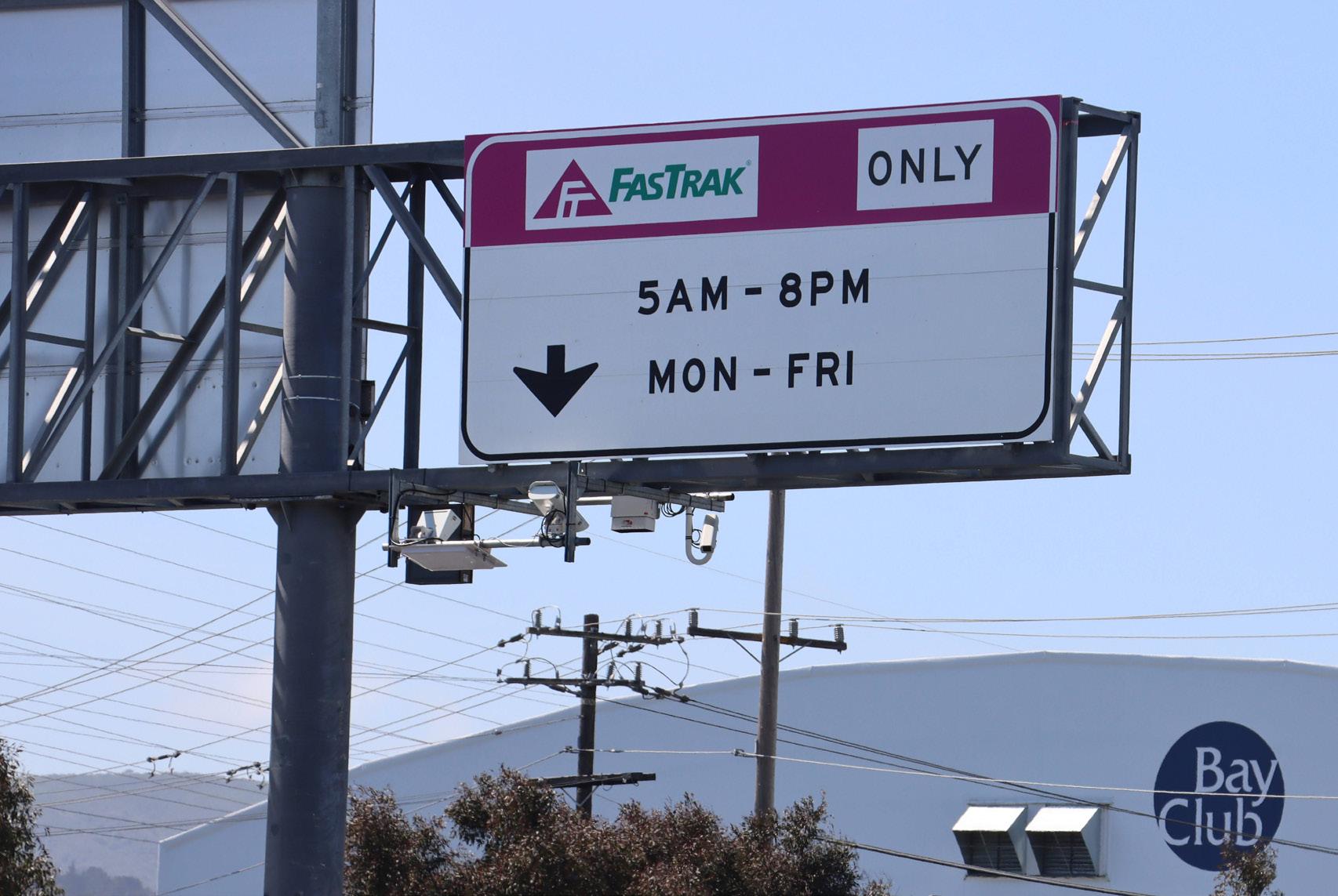 BY ALEX KELLY Business Manager
BY ALEX KELLY Business Manager
My family and I had a logistical problem last week. My sister needed to be picked up from track practice, but it was right at the time I would need to leave for my soccer practice. e priority was getting my sister picked up, and when my dad returned home with the car, Google Maps said I would arrive 10 minutes late for my 6 p.m. practice. But what Google Maps did not factor in was that I planned to use the new express lane on U.S. Highway 101, which takes me directly from Broadway to Santa Clara. Using the express lane, I shaved o 15 minutes from my expected arrival time — arriving at 5:55 p.m.
and those carpooling with three or more people can drive in the lane for free.
“I think it’s going to create incentives for people to carpool, or [encourage] more people to use Caltrain,” Burlingame Council member and San Mateo County Express Lanes Joint Powers Authority (SMCEL-JPA) board member Emily Beach said.
On top of promoting more e cient transportation, San Mateo County will also retain much of the lane’s revenue through its decision to keep the SMCEL-JPA alive, as it now oversees the express lanes which run through the county.
ese lanes aren’t just made so the county can earn extra revenue o wealthy Bay Area commuters. e County hopes to nance a transportation equity program for low-income residents of San Mateo County, which would provide access to pre-loaded clipper cards or express lane transponders.
But my punctuality wasn’t without a price. e entire trip ended up costing me $16. at’s because the express lanes have a dynamic pricing system, where prices surge when there is higher tra c — and, thus, higher demand for a shortcut. High-tra c areas can have prices of upwards of $10 at each checkpoint. ose driving with a companion get a discount on driving in the express lane, usually $1 to $2 o ,
“What we did that was different than anywhere else in the country is we put aside $1 million to pre-fund an equity program because there’s never really been a good transit bene t,” Beach said.
Despite the positives that may come with these lanes, they can also be overly expensive for students who have commutes before or a er school. In senior Finn Sheehy’s case, he’s yet to take the express lanes because of the expense.
“I look at the signs and it says a dollar or $2 from here to a couple miles down the road, and that feels like just too much, it’s not worth it,” Sheehy said.
But for those with situations similar to mine, where carpool lanes are the only option, the prices are an unfortunate necessity. Sophomore Kylan Dean drives with his mom and brother to soccer practice two nights a week, taking the express lanes for free. But on the night where he has a di erent practice time to his brother, he uses the express lane at the discounted, but still costly, rate.
“I think it’s not that necessary to have because it helps us get there much faster but all the other people have to wait who can’t a ord to pay,” Dean said. e other problem the students have is that the express lanes don’t seem to alleviate trafc in non-express lanes. While Beach expressed that modeled iterations of the highway with and without express lanes show that they do solve some tra c problems, this doesn’t appear obvious with the frequently slow tra c on U.S. 101.
“I do think there’s been more tra c because of the express
lane; [it’s] almost always empty, but the other spots are always lled up with cars,” Dean said.
Despite the gripes students and community members may have, the county will continue to strive to make its section of the express lanes as bene cial as possible.

“[ e lanes are] one part of the congestion puzzle that would use the real estate that we’ve got on the highways better and smarter,” Beach said.
Long commutes take a toll on students and sta
BY ANA LUNAPARRA Sta Reporter
For some students, commuting to school is as simple as a short walk across the street. For others, however, traveling to school can take up to two hours each morning — and there isn’t always an e cient way to arrive on time.
Until moving to Paci ca recently, therapeutic elective class teacher Jami Weatherson commuted to Burlingame from Sacramento every day. In the mornings, she commuted two hours; a er school, her drive home typically took four.
“I accepted the job and knew I was going to move but my wife couldn’t transfer for six months,” Weatherson said. “We had to stay in Sacramento for her job, but I really wanted to work here. So I just toughed it out for six months.”
However, the unpredictable tra c always remained a prima-
ry concern.
“I le my house at ve, but it still could be something that takes me more than three hours because you never know with tra c,” Weatherson said. “I would get stuck on the bridge for sometimes an hour.”
Senior Abby Sanchez, who lives near Mills Estates, added that the unpredictability of a long commute requires strict scheduling. Although Sanchez takes CalTrain in the a ernoon if her parents drive her in the morning, Sanchez has to take her car when her parents are unable to drop her o
“It’s all about timing,” Sanchez said. “When I drive to school, I have to get my stu ready and go to bed early to not lose that sleep. I also have to leave at eight o’clock on the dot, or else I can’t nd parking, and there’s a lot of tra c, and I end up being late to school.”
As a member of leadership, Sanchez has struggled with ar-
riving on time to both school and extracurricular activities.
“Going to leadership events and football games takes me longer than many others in leadership and those who live right next to BHS,” Sanchez said. “It depends a lot on the tra c.”
For those with long rides to school, spending so much time commuting can compromise aspects of their personal lives, as well as their physical and mental health.
“Just being in the car for that long can be tiring,” English teacher Mary Dhyne said. “I’d like to exercise when I get home, and it will be late, since I get home at around 5:30. en I have to make dinner and get things going, so the evening kind of gets away from us. at time that I had when we were working from home during the pandemic, I could go exercise or take a walk more easily.”
Still, Dhyne looks for the upside in her twice-daily 90-min-
ute car rides.
“I feel lucky because I can commute with my partner, and it’s really nice to have someone else in the car so we can take turns driving,” Dhyne said. “We do get that time with our son in the car as well, which is a plus, and we listen to podcasts or music.”
Furthermore, Dhyne’s emphasis on maintaining a positive attitude has allowed her to have much calmer commutes each morning.
“Carpooling with someone and having that other person has been really helpful,” Dhyne said. “I can’t control tra c, and just letting that go is important to keep in mind because you can de nitely get frustrated.”
Weatherson echoed that sentiment, saying she found ways to make her drive more enjoyable.
“I actually didn’t mind the drive, because I listened to a lot of podcasts and music, and it gave me time to myself,” Weath-
erson said. “But it did take a lot of time out of my day, as I drove about 25 to 30 hours a week.” Commutes have more of an impact on mood than most realize, something Sanchez hopes people are more understanding of.
“I think it’s important for everyone to consider that everyone has a di erent commute,” Sanchez said. “Some people take the train and I know some bike to school, so it can be stressful sometimes. You might be feeling
chaotic when you get to school, when other people can wake up ve minutes before school and then they’re just there on time.”
NEWS APRIL 18, 2023 4
I think it’s important for everyone to consider that everyone has a di erent commute.
ABBY SANCHEZ
PHOTO BY ALEX KELLY Pay toll lanes are expected to reduce travel time in Express Lanes by up to 79%.
e pay toll lane signs are present along U.S. Highway 101, marking the le most lane as the FastTrack-only express lane for people willing to pay to get to their destination faster.
SAN MATEO COUNTY TRANSPORTATION AUTHORITY
GRAPHIC BY ANA LUNAPARRA
LiTTLE HOUSES, BiG STORY
LOCAL PERSON SPRUCES UP COMMUNiTY PARKS WiTH CARVED HOUSES
 BY ABBY KNIGHT
BY ABBY KNIGHT
Whether you’re walking to school, spending time in Washington Park or heading to Burlingame Avenue, it’s almost impossible to miss the wooden house sculptures located near campus. Each sculpture is carved into a di erent, detailed fairytale-style house, and there is even a wooden wishing well close to the community center.
“I see the houses pretty o en because they’re in the park in front of our school, and I walk past it a lot, just to get from the Ave and back to school,” sopho-
more Shani Roitman said.
All of the sculptures, including the little houses, wishing well and a bench, were designed and constructed by James Delaney, the Parks and Recreation park maintenance lead worker. He started creating the sculptures in 2021 a er his fellow employee asked if he could carve something in Washington Park.
“I started carving little things around the park, like mushrooms, that I gave to the Rec class to paint up, or I was carving other things for myself [at home] like little drums for my daughters and stu . And [my co-worker] asked me if I could
do that, and I gured out how to do it,” Delaney said.
Delaney based his sculptures o of his kids’ interests in popular fantasy characters.
“I have three kids so they love, of course, Disneyland and ‘Harry Potter’. So that’s kind of the inspiration; I gured I’d do something that matched that,” Delaney said.
Woodworking caught Delaney’s attention just a er he graduated high school. He rst began constructing wood fences, for both his father’s house and his own.
“So I guess sometime a er high school I just started playing
with wood, and it morphed into whatever it became now,” Delaney said.
e number of whimsical houses and sculptures in Washington Park will increase next month, as Delaney is planning to install a fairy house dedicated to a Burlingame community member in the park’s Fragrance Garden by May 13. He is also brainstorming ideas to turn a 20-foot tall cut tree into a lighthouse, based on a proposal by two of his co-workers.

“So normally I’ll go and I’ll nd something that somebody kind of did on the internet, and then I get my ideas from them,”
Delaney said. “And if I can see it in my own head, I can almost recreate something, add a Disney air to it.”
Delaney’s sculptures are widely enjoyed by students and community members. Many students also agree that new art installations would bring even more magic to the park.
“I think because Burlingame is trying to build more community, I think artwork [in the park] that shows more community [would be nice],” junior Ashley Fong said.
Ongoing lunchtime littering leads to avian avalanche
“It’s almost as if the students are taking that service provided to them for granted,” Nuñez said.
Senior Riley O’Sullivan thinks that the problem is more than just laziness. He believes that most students simply think it is humourous to throw around food and leave trash out, especially when they initially arrive at Burlingame as freshmen. O’Sullivan acknowledges that he was initially one of those people, but that he eventually learned to be more appreciative of the campus and started throwing away his trash.
“A lot of the times we think it looks funny until the moment we realize it’s not,” O’Sullivan said.
away anytime soon. “ e tricky thing with seagulls is that they’re creatures of habit,” Li said. “So once they know there’s a food source, they’re going to set up shop and come back and that’s just kind of grown and grown over the years.”
Ultimately, she believes that the solution to the issue lies in a shared responsibility between the students and the school administration.
“I think that we need a maximum number of sta and students to get things where they’re supposed to be to help get it under control,” Li said.
bage without moving. He also highlighted that his team is enforcing end-of-lunch detention clean-ups in addition to regular detentions that require some students to collect trash around the school.
“Sometimes I think that helps because then we hope they realize it isn’t that hard to get up and throw your stu away,” Nuñez said.
BY ARDA INEGOL Web Editor
Take a look at the quad during lunch, and don’t be surprised when students are wearing their hoods on a sunny day. No, they are not in uencers trying to shield their skin from UV rays or avoid paparazzi photos. Instead, students put up their hoods to protect their heads from an ever-present swarm of seagulls.
Why? Burlingame has a major bird problem. To address this issue, the school’s sustainability

commission decided last year to implement the tri-bin system to encourage students to sort out their trash. Despite these efforts, birds continue to ock the campus and scavenge for food, leaving the administration frustrated.
According to Ernesto Nuñez, Coach E, the problem stems from student laziness and ignorance because some students leave their trash behind a er brunch and lunch. He also notes that most of the food waste stems from the free food program.
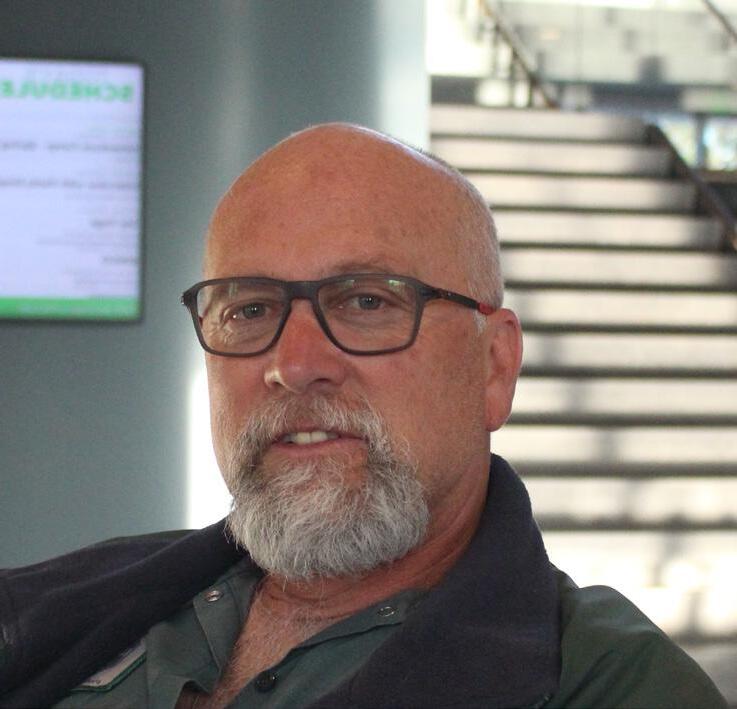
Trash that is not thrown away inevitably attracts birds such as seagulls and crows, and over time, these animals increase in number. With this comes the issue of bird droppings, and because Burlingame has large open spaces with many students eating out in the quad, this turns out to be a major problem.
“At least one student gets hit a day from bird droppings and people are running to class with their heads covered,” Nuñez said.
According to Bethany Li, an English teacher and site sustainability facilitator at Burlingame, the bird problem is not going
According to Nuñez, the administration has been doing its part. He said that he and his team consistently move trash bins next to tables and put them in strategic locations so that students can throw away their gar-
Eventually, the solution to the bird crisis boils down to whether or not students can take responsibility and throw away their trash e ectively. Li wants students to talk to their friends about the issue and identify possible solutions as a group.
“I think the peer-to-peer impact is going to be a lot more impactful than me lecturing at you,” Li said. “A grassroots movement seems like our best option for a solution.”
FEATURES APRIL 18, 2023 5
A seagull ies above the main quad at lunchtime on Wednesday, April 13, carrying a large piece of food le by a student.
Sta Reporter
PHOTO BY ABBY KNIGHT
PHOTO BY JAKE ROTHSTEIN
Italy









travel journal
From Ferrari rides to walking tours of beautiful cities and from visiting museums to watching a friend fall into the dirty canals of Venice, it’s safe to say the 2023 Italian Exchange Program was a trip of a lifetime. We (Jake, Theo, Arshia and Ana) spent the frst week of the trip with Italian host families, immersing ourselves in their day-to-day lives. We experienced a typical day at their school, visited various sites and cities in the nearby region, and some of us even faced off against them in an America versus Italy pickup soccer game (we lost, unsurprisingly).

We then said goodbye to our Italian hosts and departed for a week in Florence, Siena and Rome, touring various sites and roaming freely around the cities. We journaled some of our best experiences in Italy, from soccer games to visiting local cities such as Modena and Bologna — and as our tour guide Riccardo would always say, “let’s andiamo!”
Personal journal: Ana Lunaparra

Personal journal: Jake Rothstein
Sight-seeing in Siena
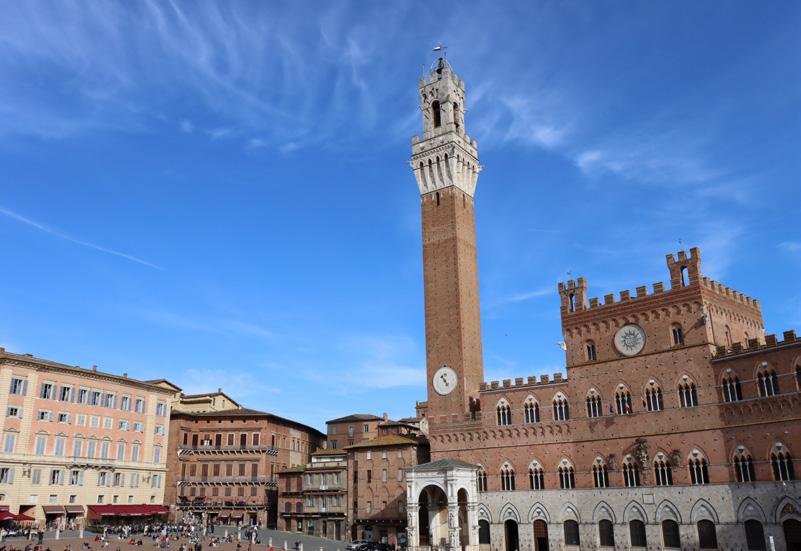
Siena was one of the most beautiful cities we traveled to, with splendid views and beautiful, peaceful neighborhoods. Walking around the city, we found a pizzeria serv- ing giant slices of incredible pizza. We went back to the same place three more times throughout our two-day stay in Siena. Also, during our stay in Siena, we climbed the “Torre del Mangia,” or Tower of Mangia — one of the many towers we climbed during the trip — to get a clear view of the entire city during the golden hour.
Personal journal: Theo Au-Young

During our frst week in Italy, each student stayed with their exchange student’s host family in Carpi. Experiencing what a family’s daily life is like in another country was one of the most memorable parts of the trip, as we noticed different customs and traditions. Because Italian students have school from Monday through Saturday, we spent the entire day with our hosts on Sunday. My host fam- ily and I woke up early to drive around Lake Garda, Italy’s largest lake. Although the drive there was around three hours, it was defnitely worth it. We drove to a view overlooking the lake and then visited several towns along the water.
After an 11-hour fight, I joined my Italian host on a long drive to the San Siro stadium in Milan, one of the largest stadiums in Europe. Inter Milan was facing off against Juventus — two historic teams competing in Italy’s most important match of the year. Even before the game started, one thing was clear — the passion for European soccer is unmatched. The atmosphere created a spectacular viewing experience beyond the game itself. From chants of “Co-come mai, co-come mai. La champions league tu non la vinci mai?” (Why can you never win the Champions League?) to incredible fan-created posters and an attendance of 75,224, it was a unique experience. The game itself was a bore, as Juventus claimed an actionless 1-0 victory. But even after defeat, the Inter Milan ultras continued to dis- play their passion for their club, heckling Juventus supporters and singing the Inter Milan anthem. The passion and love that Italian fans have beats any fandom I’ve seen.
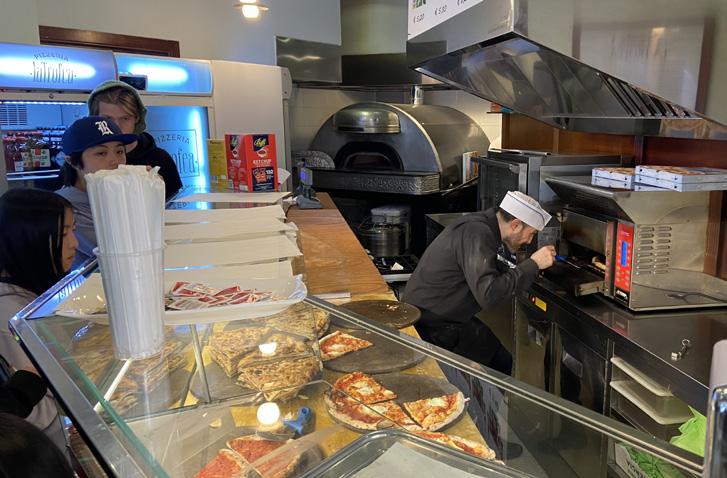


Touring Modena with our Italian hosts
Personal journal: Arshia Chakravart Afternoon in Bologna



On a beautiful Saturday afternoon, our Italian hosts took us to Modena, a city near where we were staying. We walked around, exploring the colorful buildings and churches, and stopped by to eat some traditional Italian desserts and buy music records at a little vintage market called “L’Antico in Piazza Grande.” Some of us tried an Italian McDonald’s, a more expensive ($11 for a wrap!) but higher quality version of the one in America. We strolled around the bustling streets, discussing the many cultural differences between America and Italy. Overall, it was a great experience to explore a beautiful city while bonding with our Italian hosts.
During our frst days in Italy, we barely got to hang out with our Italian exchange students due to the many planned excursions and activities we had. So, early on in the exchange, after our planned itinerary por- tion of the day was done, a group of both Italian and American students took a train and headed towards Bologna. Once we arrived, I stepped into a bustling metropolitan city, which was a stark contrast to the quiet streets of Carpi. We explored the city center and had gelato before heading back to Carpi. Looking back, I never thought what happened next would be the most tiring, yet eventful part of the day. We started from the piazza at a leisurely pace, but ended up sprinting through traffc to get to the train station on time. After getting on the train during rush hour, there were no seats available, so we had to stand for the entirety of two train transfers. That afternoon was a fun experience because any awkwardness that was lingering was gone, and I was closer than ever with my exchange student.
ITALY TRAVEL JOURNAL 6 7
Lake Garda and host families
Derby D’Italia - Inter Milan vs Juventus
Spread design by Sophia Bella, Design Ed or
PHOTO BY ANA LUNAPARRA
PHOTOS BY ARSHIA CHAKRAVARTTI
PHOTOS BY THEO AU-YOUNG
PHOTOS BY THEO AU-YOUNG
PHOTOS BY JAKE ROTHSTEIN
Madden, sophomore boys’ volleyball
A 400-METER FRONTRUNNER
Since her freshman year, junior Cora Haggarty has displayed sheer dominance in the women’s 400 meters and relays. Haggarty helped her relay team nish second in the 2021 Peninsula Athletic League (PAL) Varsity Championship and win the event in a meet the next season.
Individually, Haggarty placed rst in the 2021 PAL Final’s 400-meter competition with an incredible time of 58.76 seconds. Haggarty won six 400-meter events during her 2022 sophomore campaign and nished fourth in the Central Coast Section (CCS) Finals.

“[My] training [helped me] reach full success at the end of the season,” Haggarty said.
And this season, she hasn’t slowed down, taking rst place in the Lynbrook Invitational on March 25 and won the 200 and 400-meter events in the De Anza Invitational two weeks later, beating 57 and 34 of CCS’s best runners, respectively.
“[My goal] is to hit a [personal record], get to states and have fun,” Haggarty said. “[It’s] something that can be overlooked, but I think having fun is the most important part.”
A SEASONED SPEEDSTER
BY ARSHIA CHAKRAVARTTI Sta Reporter
Putting aside the ups and downs that boys’ varsity volleyball has faced in its short time as a program, there has been an unwavering bright spot in the last two years: sophomore Reiter Madden.
Madden has played competitive volleyball for the past seven years, which instantly made him a valuable asset for Burlingame when he joined the team as a freshman.

“As a player, he’s just very well rounded. He knows the game very well. He makes the right decisions and in some cases is very aggressive…to me that’s very exciting to watch,” head coach Lawrence Ngai said.
Madden is the Panthers’ go-to outside hitter on the squad, and one of his specialties is being a scorer they can rely on to deliver a much needed point.
“Reiter is Reiter, he always performs well, and I can always count on him for a point,” senior and varsity captain Jacob Ngai said.
Madden rst got into volleyball while going to his sister’s club practices and, through a recommendation from the coach, he tried out for the boys’ club team. At the time, the boys’ volleyball scene was still growing.
“When I started out… there were only like two teams per age group, like at max, and now there are four teams at my club… which is a huge increase,” Madden said.
Now, with the Burlingame boys’ volleyball program in its fourth year, Madden has noticed tremendous growth in participation.
“We make cuts, which is kind of like a milestone, like, you know, we have enough people at that point, which is pretty cool,” Madden said.
Alongside being a consistent scoring threat for Burlingame, Madden is a mentor for his teammates. is makes him a valuable asset for head coach Lawrence Ngai, who o en consults Madden and takes his perspective into account.
“I need feedback from them, they need feedback from me, and he’s one that provides good feedback,” Lawrence Ngai said.
On the court together six times a week, Madden has forged strong relationships with teammates.
“I go to school with these people, I see them every weekend, I have more interactions with them. So I think it’s more like a tight knit community… it’s nice to feel like that,” Madden said.
Although Madden displays a lot of skill and leadership on the court, he doesn’t plan to play volleyball at the collegiate level.
“I want to see it as a hobby in the future, just because when I go o to college, I kind of want to explore like me without volleyball,” Madden said.
For the time being though, the Panthers’ can still count on Madden and his powerful kills on the court.
“He’s just an outstanding player,” Lawrence Ngai said.
Winning has become an all-too-familiar feeling for junior Raymond Frank on the track at Burlingame.
In his sophomore year, Frank won a total of nine individual events, including the 100, 200, and 400 meters. He also helped his relay teams to vic tory in the 4 x 100 relay and 4 x 400 relay, the lat ter being in the PAL Frosh-Soph Championship. is season seems to be no di erent. In a Mar. 17 PAL meet, Frank won all four events he en tered — running the 200 meters in 23.85 sec onds, winning the 400 meters in 54.04 seconds and contributing to both victorious men’s relays.
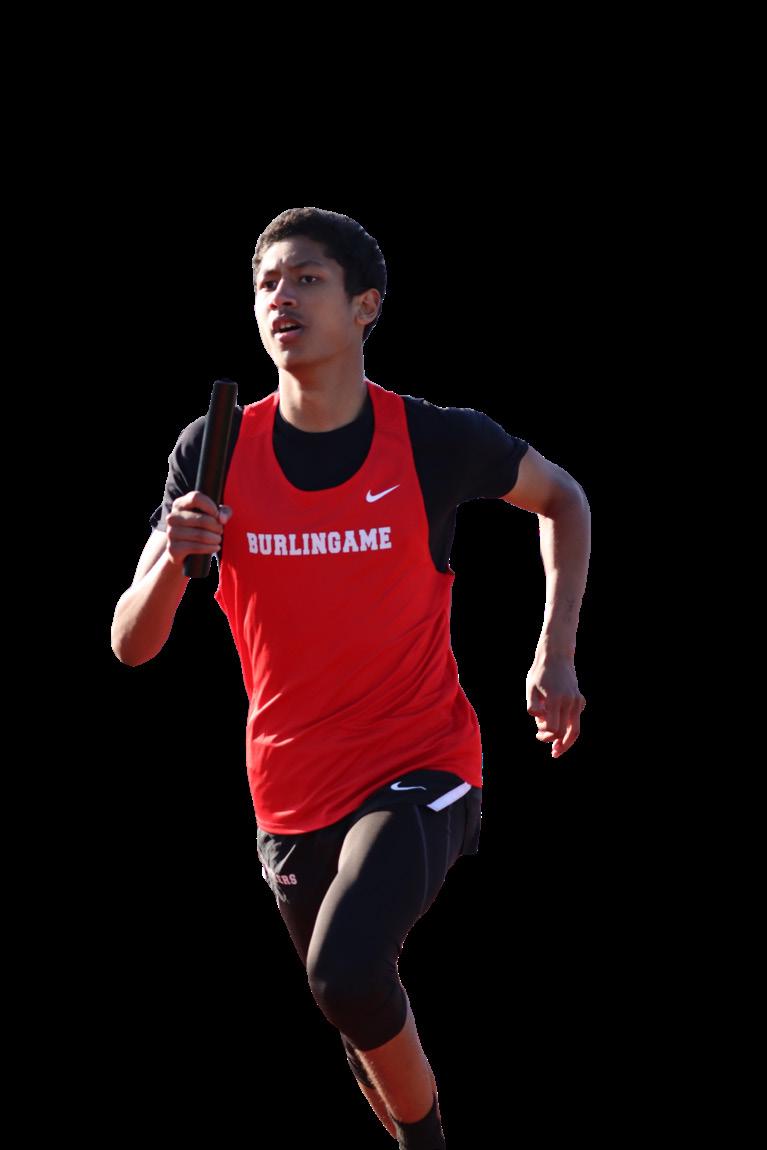
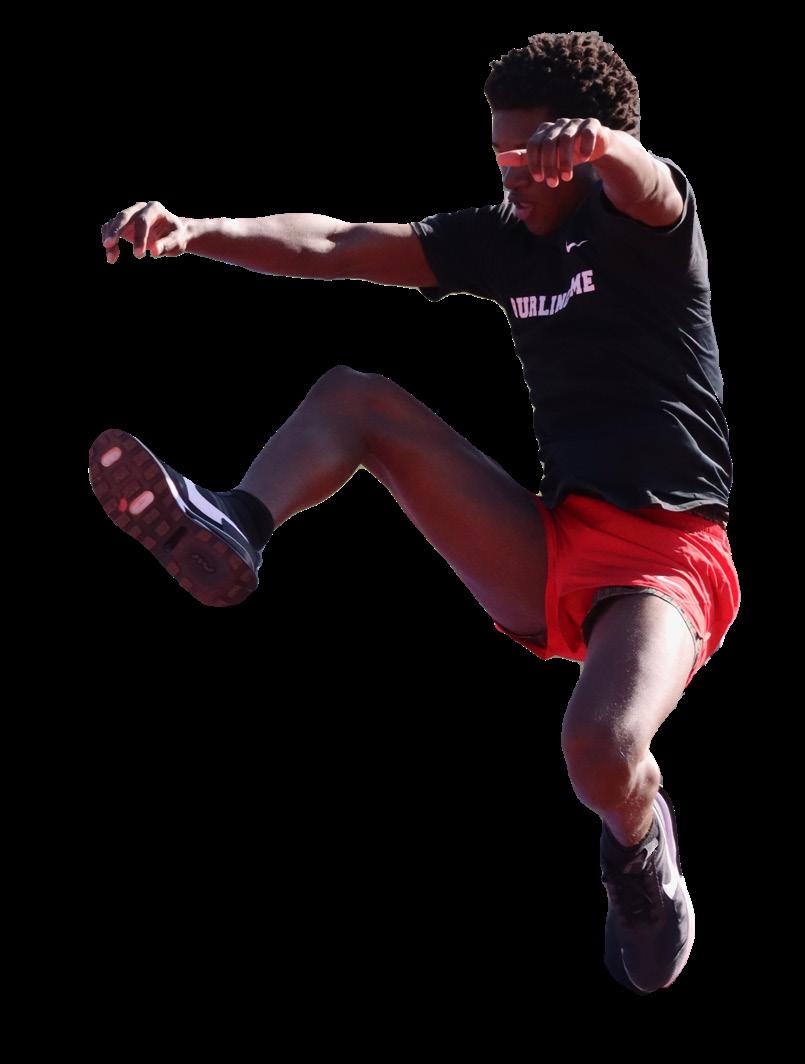
A DiSTANCE DEMON
Senior Romer Rosales-Hasek, who quali ed for CCS individually last year, has continued his success on the Panthers’ track and eld squad this season in a multitude of events.
Last year, Rosales-Hasek won three events over the span of two meets, the men’s 400, 800 and 1600 meters. Rosales opened his season with a personal best time in the 800 meters at the Saint Francis Invitational, breaking the two-minute barrier to place third out of 24 athletes.
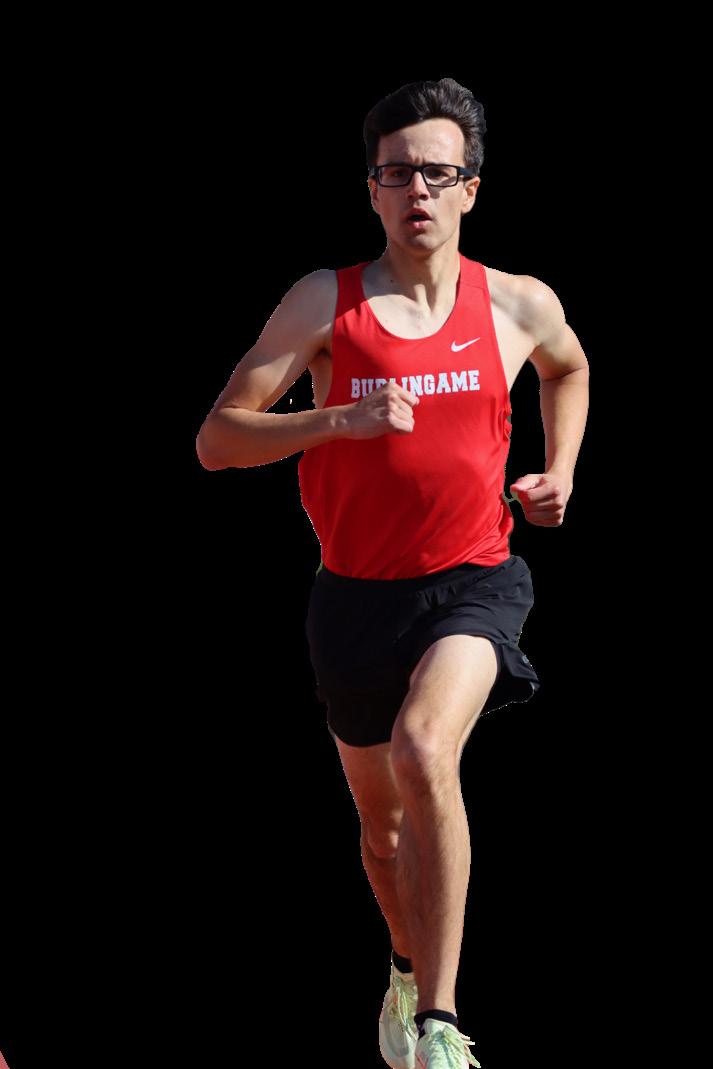
“I enjoy training both for sprinting and endurance. e 800-meter is right in between a sprint and an endurance event,” Rosales-Hasek said.
He will look to nish o his high school track career on a high note in the PAL and CCS playo s.
“My next step is to run [under] 145 seconds [in the 800 meters], which would be the school record,” Roslaes-Hasek said.
A SOPHOMORE SENSATiON
Sophomore Jeremiah Philips may have won Underclassman of the Year for boys’ basketball in the PAL South, but he has also shown out for the track and eld program. Instead of competing and running on the track, Phillips has racked up achievements in the shot put and discus events. At the rst meet of the season on March 17, Phillips was awarded rst place in both competitions with a throw of just over 37 feet in the 10-pound shot put and 93 feet, 5 inches in the 1.6-kilogram discus — over 10 feet further than the rest of the competition. Phillips, an underclassman, still has time to improve and reach his full potential, while also bringing home more shot put and discus titles.
~ Pro les compiled by Zach Newman, Sta Reporter
SPORT S APRIL 18, 2023 8
YOUNG TALENT
PHOTO BY JAKE ROTHSTEIN
PHOTO BY JAKE ROTHSTEIN
PHOTO BY JAKE ROTHSTEIN
PHOTO BY JAKE ROTHSTEIN
PHOTOBYARSHIA CHAKRAVARTTI
SHAKEN UP HOW CONCUSSiONS GO UNREPORTED iN SCHOOL SPORTS
BY ZACH SHAPIRO Sta Reporter
BY MICHELLE MOSHKOVOY Sports Editor
An estimated 1.1 to 1.9 million sports-related concussions occur annually among children and adolescents. And the concussion protocol is simple at most schools, including Burlingame: three strikes — three concussions — and you’re out.
For senior varsity soccer player Olivia Mausehund, her most recent concussion — following a routine header in a league match — put her at an uncertain crossroad: should she report her concussion, indenitely forcing herself onto the sidelines? Or should she ‘suck it up’ and keep playing?
Mausehund’s dilemma isn’t unique; in fact, according to the University of Pittsburgh Medical Center, 5 in 10 sports-related concussions go unreported. And, a study by e National Athletic Trainers’ Association found that the most common reasons for not reporting a concussion were fear of losing playing time, thinking the injury wasn’t serious and not wanting to let a team down.
e pressure to avoid medical attention doesn’t negate the physical symptoms of a concussion. According to the Center for Disease Control and Prevention, common concussion symptoms include a headache, nausea or
vom iting and balance problems and dizzi
ness.
aches, and a lot of them,” another senior soccer varsity player, Dana Brooks, said about the symptoms of her concussion. “It hurt to look at the sun, and [I was] really disoriented.” With some of these symptoms lasting up to six weeks post-injury, a concussed athlete’s focus in school may be heavily curbed. According to Mausehund, most teachers can’t accommodate concussed students in class without a note from a doctor. But, since seeking attention from medical professionals o en means the concussion will be reported, students-athletes have to choose between their sports and their classwork.
“From a neurological perspective… it’s obvious: no more football or soccer. But from a well-being perspective, it’s a little more nuanced,” said Tim Larkin, an English teacher and father of a student-athlete at Burlingame.
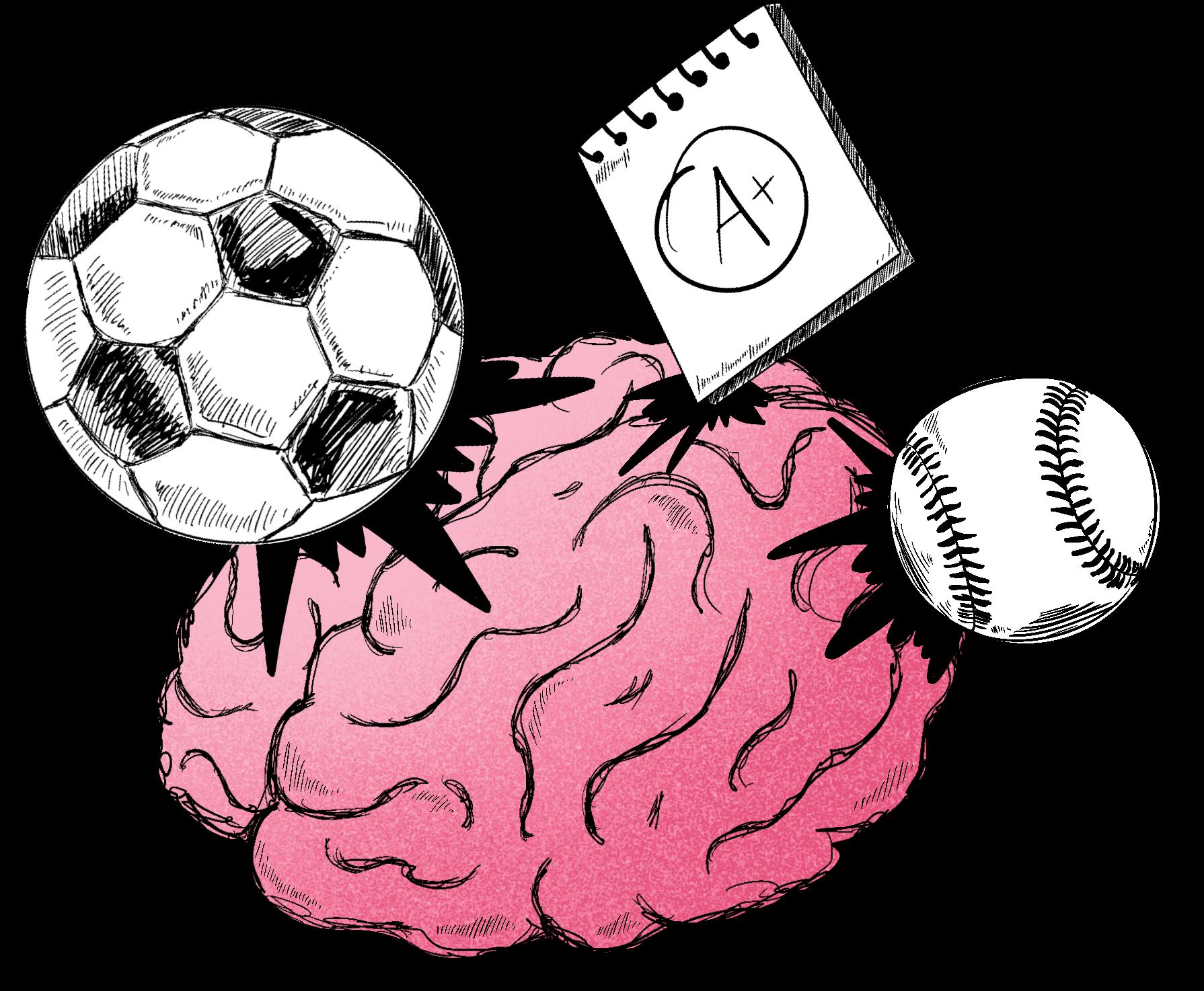
e under-reporting of concussions to medical professionals ultimately contributes to 43.5% of athletes returning to their sport too soon, according to e College of Family Physicians of Canada.
“My [concussion] freshman year was in the rst round of CCS playo s, so it felt like I
didn’t really have a choice [to sit out],” Mause-
However, student-athletes like varsity football player Pierce Schuman believe that it’s possible to nd a balance between athletic, scholastic and health priorities.
“Playing football, all my teammates are relatively afraid sometimes of getting a head injury, “ Schuman said. “But… we understand the risk, and we take measures to prevent that from happening.”
In Larkin’s opinion, the growing conversation about sports-related concussions isn’t a bad one. When he played sports in the 1980s, he remembers having two concussions — but instead of being treated for a head injury by doctors; he
was treated for a busted lip or a bruised eye.
“[When I was a kid] there was no protocol,” Larkin said. “ ere was no dark room… and especially for sports teams in those days, the coach just tells you to get up.”
Forty years later, sports medicine has vastly improved — but the under-reporting lives on.
Still, Burlingame takes considerable e orts to reduce the risk of its students’ concussions.
Athletic trainer Matt Smith attends the majority of home games for high-risk sports to keep an eye out for head contact and uses baseline testing to track cognitive ability. Strength coach Ernesto Nunez o en implements neck workouts into training programs to develop stronger muscles for bracing too.
“When you get a concussion you kind of know you have a concussion. at’s the thing, you kind of know that there’s a little something wrong,” Schuman said. “From that, I was kind of able to learn about what, as a whole, a concussion is.”
Taking the rehabilitation process more seriously is crucial as researchers and doctors around the globe gure out how to improve the diagnosis process and limit long term risk.
“Concussions, those long term implications are lifetime. It’s very, very important that you take care of your brain,” Schuman said.
AFTER RAiN-OUTS, BASEBALL RETURNS TO WiNNiNG FORM
thers’ bats started with a double to the le -center eld fence.
Shaken up, the Carlmont pitcher spiked his next pitch, then another, and Robbins was able to steal his way across home plate.
BY ZACH SHAPIRO Sta Reporter
is year’s record rainfall has caused numerous game delays for boys’ varsity baseball (2-2 PAL Bay, 6-3 overall). e Panthers just recently played their second league game and seventh game overall on April 5, while most of the PAL Bay team’s eld conditions allowed them to avoid rainouts and hit the season’s halfway mark last week.
Following that string of rainouts, Burlingame nally returned to the eld against league No. 3 Carlmont High School.
ey fought valiantly in a game
that saw both teams trade o ensive blows. However, the Panthers’ lack of gameplay caught up to them on the defensive end.
Carlmont jumped out to an early 3-1 lead in large part due to a series of errors in the in eld.
“Personally, I’m not extremely satis ed with my performance defensively,” junior St. Ignatius College Preparatory transfer Eric Gee said.
But Gee, who missed the team’s prior games due to transfer rules, was not the only one dissatis ed. By the end of the game, the Panthers had seven errors to the Scots’ two.
Will Robbins got the Pan-
In the bottom of the inning, junior Luca Scatena’s pitching remained rock solid. He e ciently retired the rst two Carlmont batters, only for the Panthers’ defensive struggles to reemerge when senior right elder Aidan Alfers overran a ground ball in the shallow out eld grass, and a ground-ball single turned into a man on second base in scoring position. On the next at-bat, another grounder got past Gee’s slide at shortstop, bringing the Carlmont runner home to lead 4-2.More small blows and defensive blunders were traded with no scoring until the sixth inning.
With just four more total outs needed for Carlmont to close out the game, junior le elder Dylan Philibosian stepped into the batter’s box with a man on second with one thing on his mind.
“I was just looking for a fastball,” Philibosian said.
And that is just what he received. On a 2-2 count, Philibosian sent one over the le eld fence to tie the game at 4-4.
Philibosian’s late game heroics were almost enough to distract from the Panthers’ lackluster defensive performance — a er all, a win is a win. But another inning le more room for error.
A er an e cient rst two outs of pitching in relief of Scatena, senior Aidan Alfers struggled to nd the strike zone, walking two batters. With two runners on base and one out to go in the bottom of the sixth inning, the next Carlmont hitter smacked a double o the out eld wall. e deep y scored both runners to regain the lead at 6-4.
Burlingame had one nal chance. At the top of the seventh inning, senior catcher Charlie Happ and pinch-hitting junior Dylan Kall started a rally, putting two Panthers on base. A so bunt up the third-base line from speedy leado hitter Noah Greenblatt moved both runners into scoring position. But, sadly, a quick two outs ended the game in a Panther loss.
“I still think we’re one of the top programs in the league,” Gee said. “Obviously our rst two games haven’t re ected that, but once we… x the mistakes we’re a top team.”
e Panthers began that re-energized campaign with a
convincing bounce-back win just two days later, knocking eight hits and tallying ve runs at home in a shutout performance at home against the Scots.
“Holden [Glavin] and [Tyler] Lachance pitched a great game which gave us a lot of momentum,” Alfers said. “We nally played together as a team.”
On April 13, the momentum continued as the Panthers pulled out a 4-3 win at Aragon High School, moving to No. 5 in the league standings. With more wins in the book and no lack of playo experience following a 2022 Division III CCS nals appearance, Burlingame will have no problems continuing to gel, in spite of missing early-season games.
Next, Burlingame will take on Capuchino High School in two back-to-back games on Wednesday, April 19 and Friday, April 21. Capuchino currently sits in No. 7 in the PAL Bay, o ering the Panthers a valuable opportunity to pick up a pair of wins.
And given that both Scatena and Gee say that team chemistry is one of the team’s main strengths, there are certainly no signs that Burlingame plans slow down anytime soon.
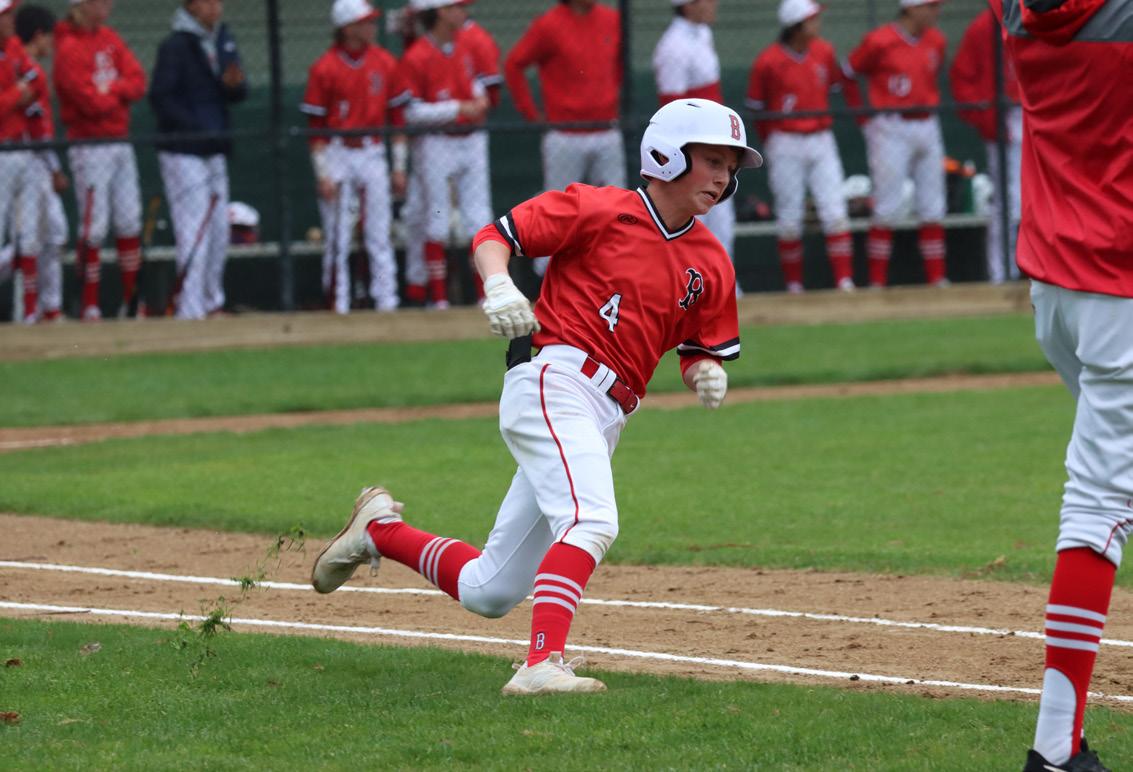 PHOTO BY JAKE ROTHSTEIN
PHOTO BY JAKE ROTHSTEIN
SPORT S APRIL 18, 2023 9
Junior Jackson Howard rounds rst base in the Panthers’ 5-0 victory over Carlmont High School on Wednesday, April 7.
AND CLASSROOMS
BY THE BURLINGAME B EDITORIAL BOARD
On Monday, April 3, the Tennessee House of Representatives voted to expel multiple House members from their chamber a er they protested gun violence on the chamber oor.
eir peaceful protest followed the Nashville shooting that took place on March 30, leaving six dead at a private Christian high school.
e representatives in question were Democrats Justin Jones, Justin Pearson and Gloria Johnson. However, Johnson, the only white lawmaker among the three, avoided expulsion by one vote. e expulsion of these representatives shocked many, leading hundreds of protesters to the city.

is undemocratic approach to politics in Tennessee should be condemned. If representatives in government are expelled for speaking out against the majority, it sets a dangerous precedent against free speech — putting the very foundation of our democracy under threat.
is doesn’t just apply to our representatives. When former indicted president Donald Trump had protestors violently
removed from Lafayette Park, he set a similar precedent. e president abused his powers in order to crush protestors’ right to demonstrate. Sadly, for many Americans, this anti-protest sentiment is becoming more common.
According to a 2020 study by the Pew Research Center, the share of Americans who believe that “people are free to peacefully protest” in the United States has fallen 73% to 60% since 2018.
Another trend gaining momentum in conservative states is increased intervention in the educational system such as banning books and education curriculums. For example, the proposed Advanced Placement African American History course was banned in Florida. In doing so, the state silenced the voices of scholars
associated with critical race theory, the queer experience and Black feminism, as well as topics such as the Black Lives Matter movement. In response, the College Board took out the aforementioned material, but Florida refused to rescind their ban.
ese examples all show how
people in power or the majority are becoming willing to crush voices for the sake of their narrative. Representatives, protests and education are under threat: essentially our ways to make a di erence in government and the future.
It’s easy to think that threats to individual freedoms only exist on television and in history books, in faraway countries and political chambers, like Tennessee’s. We o en overlook the fact, though, that free speech is vulnerable in our own backyards. irty minutes down the road, a free speech controversy has caught national attention.
e Federalist Society invited conservative judge Stuart Kyle Duncan to speak at Stanford Law School on March 9. Duncan, who currently sits on the U.S. Court of Appeals for the
Fi h Circuit, has defended gay marriage bans and supported restrictions on transgender people using their preferred bathrooms. When he attempted to speak to the crowd, he “was relentlessly heckled and traded barbs with students,” according to a recent article in e New York Times, and was unable to continue his remarks.
e right to protest is fundamental, but shouldn’t be condoned when it comes at the cost of freedom of thought and reasoned debate. Although many of Judge Duncan’s views are reprehensible, campuses are intended to be sanctuaries for free speech and debate — among students, teachers and guests — not echo chambers where it’s okay to repress viewpoints that you disagree with, whether liberal or conservative.
In a country that is becoming increasingly divided, it is more important than ever to encourage free speech and expression. e hard conversations don’t only happen in state legislatures and in the political media — open dialogue is just as essential in classrooms, school board meetings, workplaces and family gatherings.
Political division is tearing the sports world apart

Basketball Association (NBA), the two most popular sports in the country, declined to a low in 2020, and have only slowly increased in the years since the pandemic. e 2020 NBA Finals garnered just 8.3 million viewers, the lowest since ratings were recorded and a third of the 25 million viewers that tuned in for the 2015 Finals. e ratings only increased to a measly 12.5 million in 2021.
I worry that if athletes and sports leagues don’t stop alienating their audience with controversial and partisan movements instead of taking meaningful political action through lobbying and policy change, the sports world will be divided forever — and that would be a tragedy.
BY ZACHARY NEWMAN Sta Reporter
Navigating through today’s world with a positive mindset can be extremely di cult, especially when we are bombarded daily by upsetting current events and tragedies. O en, these events bring thoughts of hopelessness and anxiety about the future. Whenever I start to fall down the rabbit hole and feel increasingly distressed, I turn on the television or open my phone, and watch a sports game.
Sports — on both the collegiate and professional level — are highly entertaining for me and millions worldwide. e thrill of your team’s victory, the inspiring stories and the utterly ridiculous things athletes can do make sports an immovable part of American culture.
But sports are also uniquely
important because they provide a safe haven from the ugliness and cruelties in our world — at least they used to.
Gone are the days when I could escape the troubles and harsh realities of our world for three hours by watching the Giants hit home runs, the Warriors splash threes, the 49ers intercept passes or the Sharks score goals (well, unfortunately, they rarely score, so it’s more like watching the other team score goals).
Now, when I watch a sports game, I’m force-fed a variety of controversial propaganda, from both sides of the political spectrum, such as slogans like “Make America Great Again” (MAGA), posters promoting anti-vaccine viewpoints and jerseys supporting Black Lives Matter (BLM).
I came to watch a sports game for the entertainment and the amazing athletes, not to receive
doses of political propaganda that I get in every other element of my daily life. Even platforms that are supposed to be politically neutral, like news networks and social media applications, host pundits to spew unsolicited and insensitive political indoctrination into their viewers. Our world, and country in particular, is so politically divided that each piece of political propaganda distributed by sports leagues and associations adds more tension.
Isn’t the purpose of these political statements during sports games to bring and unite us together? Aren’t we doing these causes a disservice by shoving them in fans’ faces during sports games and alienating audiences?
Fans are reacting to the increased politicization — ratings in the National Football League (NFL) and the National
However, I don’t necessarily believe in the “shut up and dribble” idea that argues athletes shouldn’t express their opinions. Athletes are also members of society, and therefore have the right to speak out on their beliefs and are entitled to voice their opinions. at’s what this country is all about — but there is a di erence between giving your political views o the court and alienating your loyal fans on it.
To be clear, I am not advocating that athletes shouldn’t voice their opinions. I support and respect athletes that speak out for the issues they are passionate about, much like I am doing now. I believe that when there are injustices in our world (and there are many), athletes have a duty to react and create positive change. I hope athletes continue to voice their opinions whenev-
er they feel inclined to do so; I just wish it wasn’t during sports games. In other words, athletes should, as long as it is backed up with facts and truth, share their political opinions with the public, but not on the court or eld. Athletes o en share their opinions during the game by wearing political messaging on shirts, which draws focus away from the entertainment, whereas if they conveyed their ideas online, a er the games would be a ected and the athletes would maintain their platform. Why can’t they wear the shirts out in public, or the locker room? at way, they are keeping the product politically neutral, while still being able to voice their opinions. And for those who disagree with their opinions, there’s no harm, because you can either stop following them on social media or listen to their thoughts and broaden your perspectives.
Sports are meant to unite us. Where else can you get people from all backgrounds, ethnicities, religions, classes, ages and professions to all root for a single cause? ere is nowhere else we can nd that level of cohesiveness anymore. We shouldn’t infect sports, where we coexist in agreement and understanding, with a world that craves to divide us at every turn. It doesn’t matter whether you agree with the messages pushed during games or which political party you belong to, the politicization on the court and the eld is tearing the sports world apart.
OPINION APRIL 18, 2023 10
PROTECT
CONGRESS
SPEECH, iN
GRAPHIC BY SOPHIA BELLA
GRAPHIC BY SOPHIA BELLA
CREED III
BY DANNY CONWAY Sta Reporter
“Creed III” is the third installment in the “Rocky” spin-o series following boxer Adonis Creed, the son of Rocky Balboa’s longtime rival Apollo.
e lm marks the directorial debut of Michael B. Jordan, who also plays protagonist and retired heavyweight champion of the world, Adonis Creed.
Creed, at the top of the boxing world, reunites with old friend and boxing prodigy Damion Anderson (Jonathan Majors), who is fresh out of jail a er serving a sentence for a physical al-
tercation he had outside of a gas station years ago during a night out with Adonis. e viewer follows Creed as he rekindles his relationship with Anderson while juggling the perils of family life with his wife Bianca (Tessa ompson) and daughter Amara (Mila Davis-Kent).
Jordan excels in his directorial debut. While boxing movies typically follow a similar formula, “Creed III” does a good job of di erentiating itself from the crowd by incorporating larger themes than simply boxing. e actual boxing sequences in the lm are noticeably di erent from previous installments

SUPER MARIO BROS.
BY ALEX KELLY Business Manager

If you’re looking for a great animated movie, like Despicable Me or one of the beloved Pixar movies, “ e Super Mario Bros. Movie” is not that. e movie falls short on story, with short-lived plotlines and no real meaningful takeaway.

But, at the end of the day, this movie is targeted at kids, and there are certainly moments to laugh at and enjoy. Jack Black has a fantastic performance as a love-stricken Bowser, and he even sings a romantic ballad to Peach.
For any video game nerd, there are numerous references to the various Mario games, and the Mario Kart scenes are especially faithful to the original game. e score also does a great job of honoring the original games, with recognizable music appearing throughout the movie. e animation is also top-notch, which truly brings the video game characters to life. Of course, don’t go to this movie expecting an Oscar-winning animated lm — go instead to laugh with, and sometimes at, a decent, nostalgic video-game movie.




as well. Jordan says he drew inspiration from Japanese anime during the creative process, using several camera angles and special e ects to give the ghting some extra excitement.
“Creed III” has solid dialogue, acting and cinematography, establishing that the Creed series can stand on its own rather than in the shadow of the Rocky franchise.
DAISY JONES & THE SIX
BY ATHENA BOSTONMAER Sta Reporter
Given how realistic and immersive the television show was, I was shocked to hear that Daisy Jones & e Six, the band created by Taylor Jenkins Reid in his eponymous novel, was not a real band.
e story focuses on band members in the ‘70s, a decade that in uenced rock music. Inspired by the iconic Fleetwood Mac, Reid created a ctional band with a hidden backstory of






THE MANDALORIAN
BY SOPHIA PUZON Sta Reporter
e third installment of “ e Mandalorian” was highly anticipated by Star Wars a cionados and casual viewers alike who tuned in to watch the adventures of bounty hunter Din Djarin and his pint-sized companion, Grogu (who fans call Baby Yoda). is season, Din seeks to atone for taking o his helmet and revealing his face to others, something strictly forbidden in the Mandalorian code.
I enjoyed the return of characters from the previous seasons. e bounty hunter-turned-magistrate Greef Karga and fellow Mandalorian Bo-Katan Kyrze have more signi cant roles in the third season. However, this came at a cost — the show’s title character, the Mandalorian, is pushed behind the rest of the action, leading to minuscule screen time.

I also felt the new season relied too much on background information. In the previous season, Grogu and Din were
separated. I have not kept up with the various Disney+ Star Wars series, and thus missed out on their reuni cation in another Star Wars story, “ e Book of Boba Fett”, leading to my initial confusion when I saw the pair suddenly back together. Overall, while the return of familiar characters was enjoyable, the limited screen time for Din and an overreliance on background information from the other shows le me confused, and I didn’t enjoy the season as much as I wanted to.
drug abuse, love-triangles and, of course, rock-and-roll.
In the show, co-stars Sam Cla in and Riley Keough, who played Billy Dunne and Daisy Jones, brought the band to life through their vivid live-performances and original songs. In fact, the songs are now available on all streaming platforms.

Award-winning musicians Blake Mills and Phoebe Bridgers played a critical role in portraying Reid’s vision and developing the soundtrack.
ough the music is excel
lent, I found the characters in the show to lack sophistication and depth. While the novel developed the distinct personalities of each character, the lm adaptation exaggerated the characters’ quirks to the point that they lost their realism. is made some of the characters unlikable, as they seemed shallow. Despite its lack of character development, overall, the show includes well-done classic ‘70s music and does a good job of visually capturing the style and vibe of the ‘70s.
ENTERTAINMENT APRIL 18, 2023 11
GRAPHICS COURTESY OF UNIVERSAL STUDIOS
PHOTOS COURTESY OF DISNEY
PHOTOS COURTESY OF METRO-GOLDWYN-MAYER PHOTO COURTESY OF AMAZON
Diversity takes center stage at cultural assembly
JEANNINE CHIANG Sta Reporter
On Wednesday, April 5, Burlingame hosted a full-scale cultural assembly for the rst time since 2020. Launched in 2008 by English teacher Sophie Abitbol, the spring assembly celebrates the diverse heritage of students through a series of performances.

In out ts ranging from Irish rhinestone dresses to Chut ai blouses, students performed seven unique routines during the assembly: “Decades Medley” by senior Michelle Moshkovoy, “Big Fish Instrumental” by junior Ariel Yuan and freshman Michelle Shay, “Wig-
wams, Norwegian Glam Rock Dance” by junior Tyler Wong, “Khim Instrumental” by junior Tanat Alberts and Myla Pallera, “Bakit Pa” by senior Arriana Cruz, “Irish Dancing” by junior Mathilda Haskell and freshman Scarlett Bounds, and Korean pop dancing by the Dance club.
e goal [of the cultural assembly] is letting students showcase what they’re most proud of in their own heritage. It creates a way for us to appreciate the gi s and contributions of various cultures that are immersed in our student body,” English and Leadership teacher Bethany Li said. “It’s nice to have an assembly that’s really student-focused and when we
talk about being an inclusive campus, events like this show that that’s really happening.”
Because of COVID-19’s restrictions on large gatherings of people, the cultural assembly has been modi ed for the past two years: In 2021, Leadership compiled virtual submissions into a video, and students performed on the outdoor stage last spring. Nevertheless, throughout senior Arriana Cruz’s high school career, she aspired to perform a song that would share her heritage and leave a lasting mark on Filipino culture. is year, she nally got the chance to do it.
“I believe nowadays in society, a lot of students are afraid
to show their own culture. I feel like me taking that step and joining the cultural assembly really brings out and introduces everyone to that culture and makes everyone who is also a part of the Filipino culture feel that their culture is getting recognized,” Cruz said.
Junior Mathilda Haskell and freshman Scarlett Bounds shared a similar perspective on being able to perform a dance that celebrates their Irish heritage.
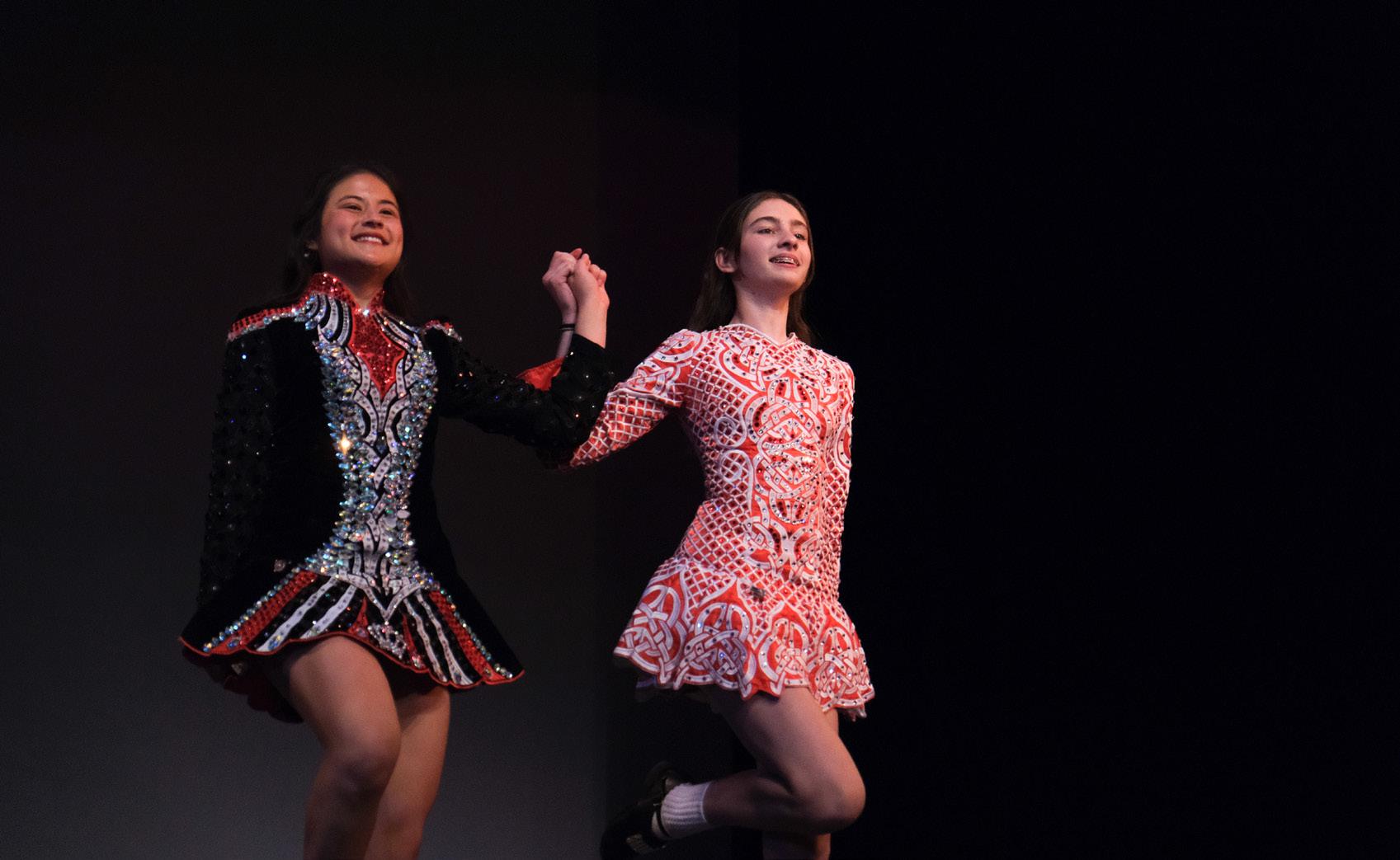
“I’ve grown up doing Irish dancing my entire life so it’s really cool [because it’s] become a really huge part of my life,” Haskell said. “Being able to express that and show something that others don’t know about has been a really cool experience.”
Much like the duo, junior Tanat Alberts and Myla Palle-
JACKSON SPENNER
ra conducted a unique performance signi cant to their ai culture. e Khim, a stringed musical instrument that originated from Mesopotamia and Persia, produces a bright and expressive sound.

“I received my instrument from the ai Temple, which is in San Bruno. We did a few practices [before the cultural assembly] and on the last one, I was given the out t from Tanat’s mom, and she told me that it’s a very traditional out t which I love,” Pallera said.
With 17 total student performers, the assembly showcased the diversity of culture and talent at Burlingame.
“It’s just really beautiful to see all the di erent types of cultures up on stage getting the recognition that they deserve,” Cruz said.
1 Young fellow 2 Language su x 3 ey may help for sneezing or crying 4 “Nobody knows” 5 Insigni cant one 6 Storm (in) 7 Real ___ agents 8 A120, at Burlingame 9 Milk’s favorite cookie 10 Popular dance move of the 2010s 11 Common classroom supplies 12 ___ languages (Italian, Spanish and others) 13 Colonel Sanders’ beard, for instance 21 “Hold on a ___!” 23 Quarterback Brady 24 Batter’s stat 25 March 15, for Ted Lasso Season 3 28 Hosp. scans 29 Dole (out) 31 “... ___ saw Elba” 32 Extinct ightless bird 35 Unprepared 37 Perched on 38 Ancient astronomer proved to be wrong by Copernicus 40 Lists on eBay, say 41 Purring pet 42 ere are 24 in a day: Abbr. 43 A teacher may grade these 44 Su x with super 45 Winter melon (sorry, this is a stupid clue!) 49 Super ___ 50 Get progressively narrower 52 “No ___, no gain” 54 Cry of discovery 56 Permit 57 Dra org. DOWN STUDENT LIFE APRIL 18, 2023 12 1 Title of a Beatles song, album and movie 8 Silent agreement 11 100 nanojoules 14 Harry Styles #1 hit that became Spotify’s moststreamed song of 2022 15 Chapter in history 16 Australian hopper, for short 17 You may not have room for it 18 Spiderman’s weapon 19 Instagram Q&A session 20 “Wide ___ Sea” (AP Lit novel) 22 College admissions test 23 Music student, perhaps 25 Philosopher Descartes 26 Follow orders 27 Shopping on Amazon, e.g. 30 Shot an airball, say 33 “Otherwise . . .” 34 Scan-___ 36 Tiny bug 37 Swimsuit brand 39 Use Google 43 Devoted to one’s country 46 Scorch 47 “ is is not ___” (warning label) 48 Exams that high-schoolers o en take in their parents’ cars 51 Friend 52 Convince 53 Summer, in France 54 Battery size 55 Shocks 58 ___-com 59 Concealed 60 Small VWs 61 Secret agent 62 “Pick a card, ___ card” 63 Takes to jail DOWN
CROSSWORD burlingamebapril 1 2 3 4 5 6 7 8 9 10 11 12 13 14 15 16 17 18 19 20 21 22 23 24 25 26 27 28 29 30 31 32 33 34 35 36 37 38 39 40 41 42 43 44 45 46 47 48 49 50 51 52 53 54 55 56 57 58 59 60 61 62 63 ACROSS 1 Title of a Beatles song, album and movie 8 Silent agreement 11 100 nanojoules 14 Harry Styles #1 hit that became Spotify's most-streamed song of 2022 15 Chapter in history 16 Australian hopper, for short 17 You may not have room for it 18 Spiderman's weapon 19 Instagram Q&A session 20 "Wide ___ Sea" (AP Lit novel) 22 College admissions test 23 Music student, perhaps 25 Philosopher Descartes 26 Follow orders 27 Shopping on Amazon, e.g. 30 Shot an airball, say "Otherwise . . ." 48 Exams that high-schoolers often take in their parents' cars 51 Friend 52 Convince 53 Summer, in France 54 Battery size 55 Shocks 58 ___-com 59 Concealed 60 Small VWs 61 Secret agent 62 "Pick a card, ___ card" 63 Takes to jail DOWN 1 Young fellow 2 Language suffix 3 They may help for sneezing or crying 4 "Nobody knows" 5 Insignificant one 6 Storm (in) 7 Real ___ agents 8 A120, at Burlingame 9 Milk's favorite cookie 10 Popular dance move of the 2010s 23 Quarterback Brady 24 Batter's stat 25 March 15, for Ted Lasso Season 3 28 Hosp. scans 29 Dole (out) 31 "... ___ saw Elba" 32 Extinct flightless bird 35 Unprepared 37 Perched on 38 Ancient 43 A teacher may grade these 44 Suffix with super 45 Winter melon (sorry, this is a stupid clue!) 49 Super ___ 50 Get progressively narrower 52 "No ___, no gain" 54 Cry of discovery
Spelling ee N
O T Words must be at least 4 letters and include the center letter. 4-letter words are 1 point, longer words are 1 point per letter. Words that use every letter are worth 7 additional points. Submit your word list to theburlingameb@smuhsd.org to win! THE GAMES SECTION
ACROSS
BY
M S A U
THE GAMES SECTION THE GAMES SECTION SOLVE ONLiNE (WiTH ANSWERS!)
BY
Le : Junior Mathilda Haskell and freshman Scarlett Bounds perform an Irish dance in colorful costumes. Right: e Dance club performs a dance cover to a combination of popular South-Korean songs that each showcase a di erent aspect of K-pop.
PHOTOS BY SOPHIA BELLA
 BY ISABEL LIU Copy Editor
BY ISABEL LIU Copy Editor


 BY BRINDA IYER Sta Reporter
BY BRINDA IYER Sta Reporter










 BY ALEX KELLY Business Manager
BY ALEX KELLY Business Manager

 BY ABBY KNIGHT
BY ABBY KNIGHT
























 PHOTO BY JAKE ROTHSTEIN
PHOTO BY JAKE ROTHSTEIN

















